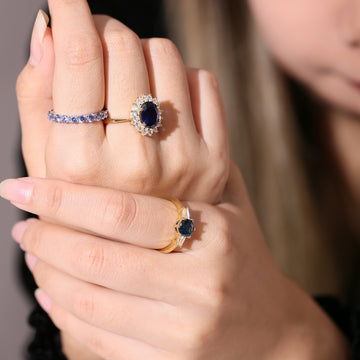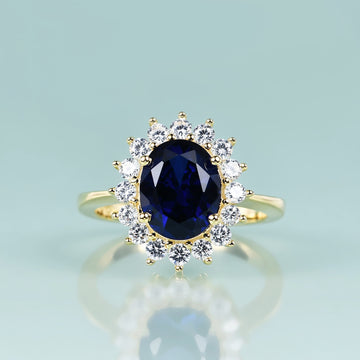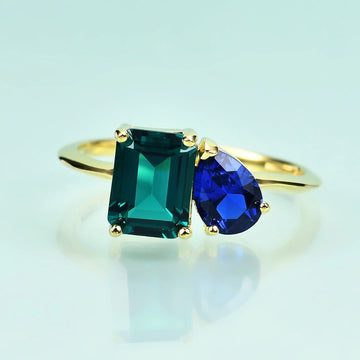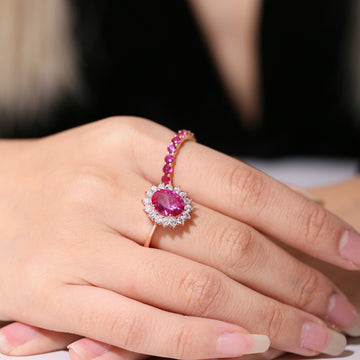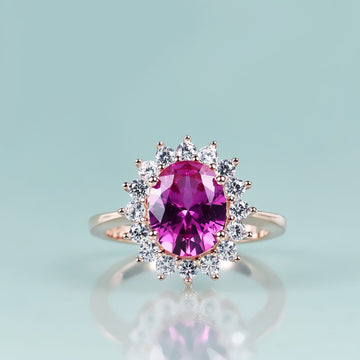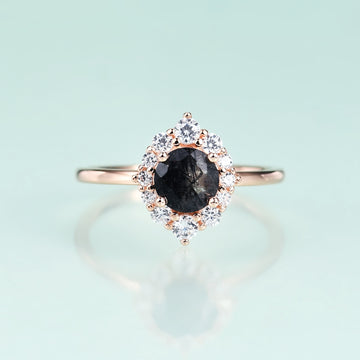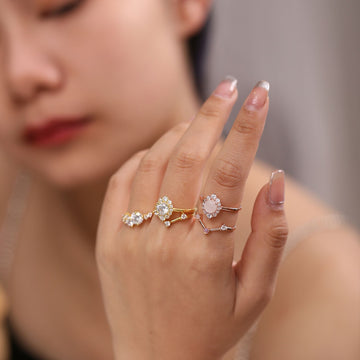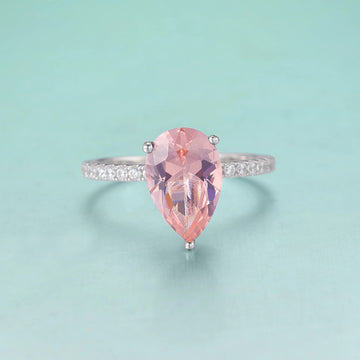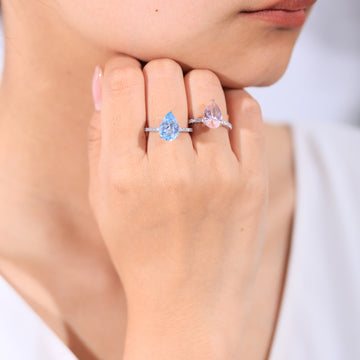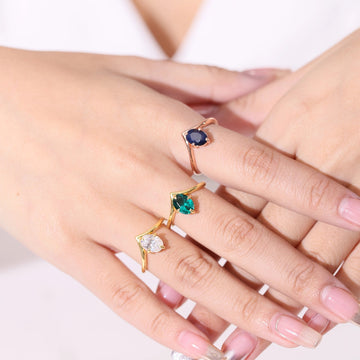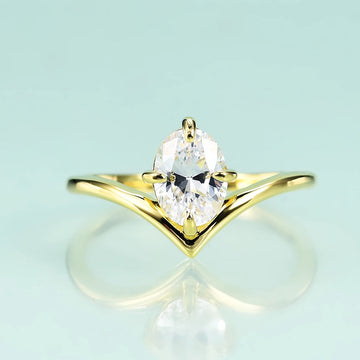8 Best Diamond Alternatives That Look Like Diamonds but Might Be Better!
Oct 01, 2025
Diamonds have been put on a pedestal since ancient times. Some evidence even suggests that the business of diamond mining started as long ago as 600-800 BC in ancient India.
Diamonds are certainly beautiful and highly sought after, but for many of us, their main downside is the price. Luckily, though, there are many ethical diamond alternatives that look like diamonds but might be better out there.
Why Choose Diamond Alternatives? Pros
1. Pricing
A large part of the reason many people choose diamond alternatives is the cost. After all, since diamonds are usually about $4500-$6000 per carat, even small diamonds can be very expensive.
For some people, purchasing diamonds is out of the question. For others, spending that much on jewelry isn't an expense they can reasonably justify.
2. Ethical Concerns
But often, concerns over the ethics of diamond mining lead people to look for alternatives.
You've likely heard the term "blood diamond." This refers to a diamond that has been mined in a war zone and then sold to provide money for military operations.
Since there aren't as many bloody civil wars in Africa as there once were, it's easy to mistakenly believe that most of the ethical issues around diamond mining have evaporated.
Unfortunately, the diamond mining industry is still rife with injustice and exploitation. Many diamond mines still use forced labor tactics, beatings, and even torture.
And even though diamonds are extremely valuable, diamond miners are extremely underpaid. Even in very poor countries, diamond miners are among the poorest citizens and struggle to afford basic necessities.
Labor laws are typically absent or not enforced, so most diamond mines pose a serious safety risk for workers. Child labor is often used as well.
Some people point to the Kimberley Process, a diamond certification process, in order to argue that issues of violence and injustice in the diamond industry have been resolved.
But unfortunately, this process labels diamonds "conflict-free" as long as they have not been used to finance a rebel militia. That leaves a lot of room for human rights abuses.
3. Climate Concerns
Diamond mining is often done without a lot of planning. As a result, it causes severe environmental damage.
Erosion and deforestation are sometimes so severe that nearby people have to relocate. Wildlife are harmed when rivers are re-routed so riverbeds can be mined. When mines are abandoned and pits left in the ground, those pits fill with water and increase the populations of malaria-carrying mosquitos.
Cons
1. They Are Not as Hard and Durable as Natural Diamonds
Of course, there are some potential downsides to diamond alternatives. In some cases, they are not as hard and durable as natural diamonds.
That might not sound like a big deal, but think about the stress placed on a piece of jewelry worn every day, especially a ring. It may bump or scrape into things, be run under water, etc.
In a stone that's less durable than a diamond, that wear can cause scratches, dullness, and even eventual breakage.
2. Less Sparkle and Brilliance (Except for Moissanite)
Many diamond alternatives simply don't have the sparkle and brilliance that diamonds do.
After all, diamonds became high-value stones for a reason; even ancient peoples could appreciate their shine and character. Thus, in many cases, diamond alternatives aren't viewed as being as valuable as diamonds.
And especially in symbolic pieces of jewelry (like engagement rings), the value of the stone is sometimes associated with the value of the relationship itself.
How to Choose Diamond Alternatives: The Guide
Though they're beautiful, diamonds raise concerns for a lot of people. But if you're considering diamond alternatives, you might be wondering where to begin. After all, there's a massive variety of diamond alternatives across the world.
Here's a quick guide so you can compare diamond alternatives side-by-side with natural diamonds.
Before we begin, let's take a quick look at the properties of natural diamonds:
Natural Diamond
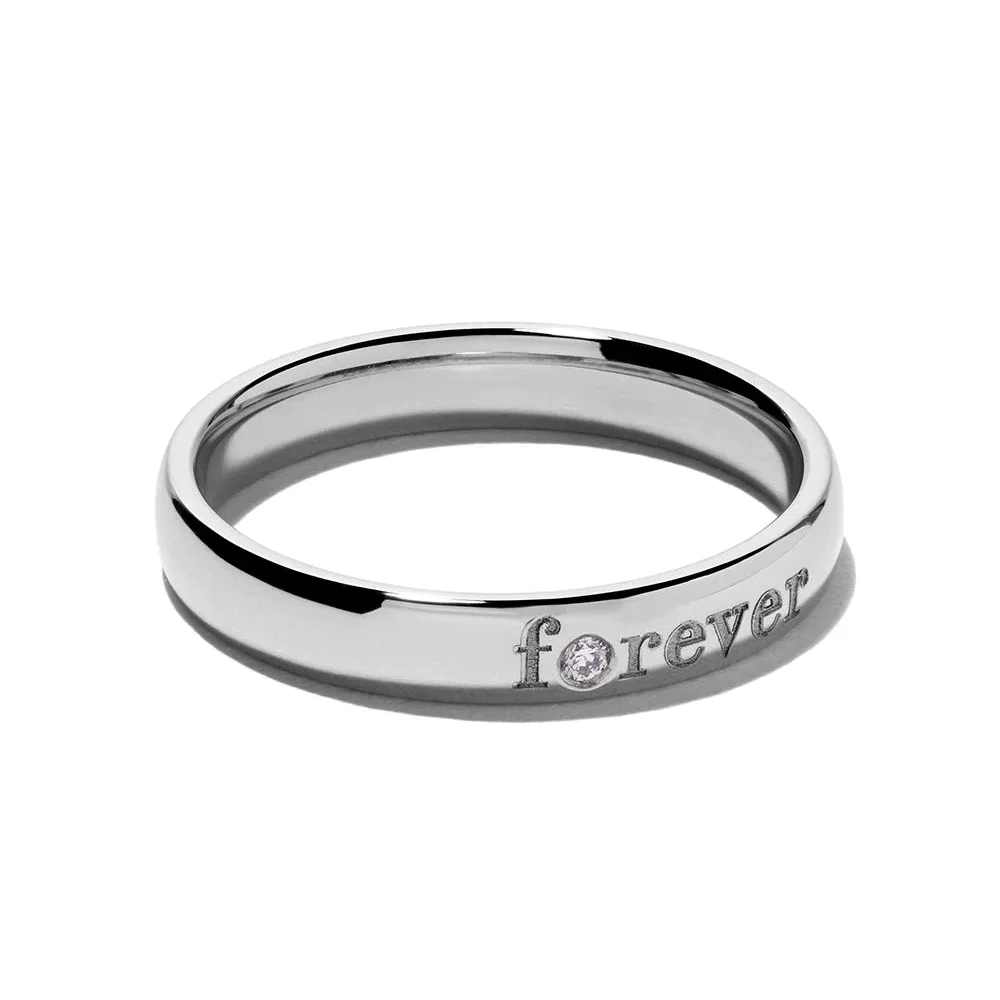
De Beers Jewellers Platinum Forever diamond band $1250, SHOP NOW.
- Price per Carat: about $4500-$6000
- Hardness: 10 on the Mohs scale
- Durability: extremely durable
- Brilliance: 2.42 refractive index
- Fire: 0.044
At a hardness of 10 on the Mohs scale, natural diamonds are the most durable stone you can get -- that's why they are often used for cutting in industrial applications.
They're known for their brilliance, which is quantified by the refractive index (the higher the number, the greater the brilliance).
Compared to other natural stones, diamonds also have a good bit of fire (also called dispersion), or color refracted. The higher the value for fire, the more color you see when light shines onto a stone.
Now, we'll take a look at the diamond alternatives:
1. Lab-Made Diamond
- Price per Carat: About $800-$1000
- Hardness: 10 on the Mohs scale
- Durability: extremely durable
- Brilliance: 2.42 refractive index
- Fire: 0.044
Lab-made diamonds are diamonds; they have the exact same structure and chemical composition as natural diamonds do. They are created in labs where exacting conditions mimic the natural conditions that cause diamonds to form from carbon.
Lab-made diamonds are extremely durable and versatile, and like diamonds, they can be found in virtually any cut. They are cheaper diamond alternatives and come with none of the ethical concerns.
However, they are more expensive than most other diamond alternatives.
Pros compared to natural diamonds:
- Fewer defects than natural diamonds
- Can come in colors not found in natural diamonds
- More affordable
- Don't involve mining
Cons compared to natural diamonds:
- Some people view them as less valuable
- Some testing equipment may mistakenly identify them as moissanite
2. Moissanite
- Price per Carat: about $400
- Hardness: 9.25 on the Mohs scale
- Durability: very durable
- Brilliance: 2.65 refractive index
- Fire: 0.104
Moissanite has become the most popular diamond alternative! Natural moissanite is a rare stone that shines brighter and has a more stunning fire than diamonds, while costing 1/10th of the price of diamonds!
At a 9.25 Mohs scale hardness, just below that of diamonds (10) and higher than any other gemstone, it gets very close to the durability of a natural diamond!
Therefore, it is unlikely to be scratched or cracked and will last forever.
You may have noticed, too, that it has a refractive index (2.65) even greater than that of a diamond (2.42); that means it has even greater brilliance.
Similarly, its fire (0.104) is also greater than that of a diamond (0.044). While diamonds have a sparkle that is mostly white, moissanite has a rainbow sparkle!
Just like diamonds, moissanite can be found either as a naturally occurring stone or as a lab-created stone. Lab-created moissanite has the exact same chemical and structural properties as natural moissanite, just like lab-created diamonds are identical to natural diamonds.
Thanks to its beauty and overall similarity to a diamond, moissanite is currently the #1 diamond alternative, especially for engagement rings.
Pros compared to natural diamonds:
- Much more affordable
- Has greater brilliance
- Refracts more color
- Doesn't pose ethical concerns
Cons compared to natural diamonds:
- Some people might prefer the more understated fire of diamonds
- It isn't considered to be as valuable

Rosery Poetry 3-carat moissanite ring oval cut $220, SHOP NOW.
3. White Zircon
- Price per Carat: about $35-50
- Hardness: 7.5 on the Mohs scale
- Durability: fairly durable
- Brilliance: 1.9-2.0 refractive index
- Fire: 0.038
Though the name sounds like cubic zirconia, white zircon is a different stone. It is naturally occurring but still very affordable.
Though its brilliance isn't as high as that of a diamond, zircon that is cut well has a level of brilliance that can come close to that of diamonds. Often, round white zircon stones have a "zircon cut" that looks like a brilliant cut but has extra facets.
Thanks to its brilliance and affordable price point, white zircon is a fairly popular diamond-like stone. In fact, before moissanite was discovered as an option, white zircon was the top diamond alternative.
Pros compared to natural diamonds:
- Much more affordable
- Well-cut stones can be confused with diamonds
- Natural impurities mean you can find it in other colors
- Zircon mining doesn't raise all the issues diamond mining does
Cons compared to natural diamonds:
- Isn't quite as brilliant
- Lower hardness makes it less durable
4. Cubic Zirconia
- Price per Carat: About $20-$100
- Hardness: 8.25 on the Mohs scale
- Durability: fairly durable
- Brilliance: 2.2 refractive index
- Fire: 0.06
Cubic zirconia is an artificial stone that is commonly used as an inexpensive diamond alternative.
Since it is a diamond simulant, some people mistakenly think cubic zirconia is the same as a lab-grown diamond. However, lab-grown diamonds are chemically and structurally the same as natural diamonds.
Cubic zirconia is very affordable, but it is less durable than diamond. That means that it can scratch or chip over time. That being said, it is common and popular enough that you can find it in virtually any cut.
Pros compared to natural diamonds:
- Much more affordable
- Much more readily available
- Even inexpensive stones have excellent clarity
- Can be found in almost any cut
Cons compared to natural diamonds:
- Not as brilliant
- Is often considered to be "cheap" and not valuable
5. White Quartz
- Price per Carat: about $2
- Hardness: 7 on the Mohs scale
- Durability: fairly durable
- Brilliance: 1.54 refractive index
- Fire: 0.008
If you want a natural stone that is still inexpensive, quartz is a good choice, as it's the least expensive alternative.
That being said, it's very easy to distinguish white quartz from a diamond. It's a great stone on its own merit, but it isn't the best diamond substitute. As a result, it's not a popular diamond alternative.
Quartz is not as durable as diamond, so it may not be the best choice if you need a durable stone. Its relative softness also limits the variety of cuts you can find.
Pros compared to natural diamonds:
- Much more affordable
- Impurities and inclusions can add interesting color
- It has a soft sparkle that some people like
- It's more readily available
Cons compared to natural diamonds:
- Much less brilliant
- More prone to scratches and damage
6. White Sapphire
- Price per Carat: about $200
- Hardness: 9 on the Mohs scale
- Durability: extremely durable
- Brilliance: 1.76 refractive index
- Fire: 0.018
Many people don't know this, but pure natural sapphires are actually white. If you're interested in a beautiful natural stone as a diamond alternative, they're a great choice.
That being said, they don't mimic diamonds as closely as some other alternatives on the list.
While diamonds have a clear sparkle, white sapphires have more of a glowy appearance. Some people prefer this look, and white sapphires are lovely stones in their own right.
However, since they are almost as durable as diamonds, white sapphires can be cut in the same or similar ways.
These stones are extremely rare in the natural world. But that doesn't mean you won't be able to find one; white sapphires can be created in the lab as well.
Pros compared to natural diamonds:
- Also a natural stone
- Almost as durable
- Has a subtle glow that some people prefer
- Much more affordable
Cons compared to natural diamonds:
- Easy to distinguish from a natural diamond
- Generally not viewed as being as valuable
7. White Topaz
- Price per Carat: about $5-$50
- Hardness: 8 on the Mohs scale
- Durability: very durable
- Brilliance: 1.62 refractive index
- Fire: 0.014
Most of us think of topaz as being a beautiful golden color, but white topaz also exists in nature. It's commonly used in jewelry, especially as an accent stone.
Well-cut white topaz has a good bit of sparkle, but it's less brilliant than a diamond. As a result, it doesn't mimic diamonds as closely as some other options on the list.
Usually, when white topaz is used as a diamond substitute, a round cut is used. However, in order to ensure maximum sparkle, the stone needs to have sufficient depth.
Whether you want to use it as a diamond substitute or otherwise, white topaz is a great-looking stone that won't break the bank.
Pros compared to natural diamonds:
- Much more affordable
- Also a natural stone
- More readily available
- Can come in similar cuts
Cons compared to natural diamonds:
- Not as durable
- Generally not viewed as being as valuable
8. Goshenite
- Price per Carat: about $20-$100
- Hardness: 7.5 on the Mohs scale
- Durability: fairly durable
- Brilliance: 1.58 refractive index
- Fire: 0.014
Goshenite is a colorless variety of a mineral called beryl. Beryl is pretty common in the jewelry world, as emerald is a green variety of beryl. Morganite and aquamarine are beryl varieties, too.
Goshenite often has great clarity. However, as you can see, its refractive index and fire are lower than those of diamond. As a result, goshenite isn't likely to be readily mistaken for a diamond.
It's less durable, too, so your cut options aren't as extensive. Nonetheless, it's a lovely stone in its own right and looks especially nice set beside smaller, more colorful stones.
Pros compared to natural diamonds:
- Much more affordable
- Can be cut into large stones
- More readily available
- Mining doesn't pose the same ethical issues as diamond mining
Cons compared to natural diamonds:
- Not very convincing as a diamond substitute
- Doesn't have a whole lot of brilliance or fire
Which Diamond-Like Stones are Best?
Now you can see that there's a huge range of potential diamond alternatives for engagement rings out there. And while any one is a solid choice, most people agree that the best diamond alternative is moissanite. But why?
For one, moissanite doesn't come with the ethical concerns that surround diamonds. Moissanite mining doesn't generally involve forced labor or using gem sales to finance rebel militias, and it doesn't have nearly the same environmental impact that diamond mining does. And in some cases, moissanite is made in the lab.
Plus, it's substantially more affordable. It costs 1/10th of the price of diamonds.
But that affordability certainly doesn't mean that moissanite appears cheap. In fact, as we saw above, moissanite actually has greater brilliance than diamonds do.
And if you like color, you'll love the fact that moissanite has a rainbow glimmer effect compared to the mostly-white sparkle that diamonds offer.
It's highly durable and can come in almost any cut.
Thanks to its relatively recent popularity, moissanite is also offered by many jewelers and online retailers. So unlike rarer diamond alternatives like white sapphire, moissanite is easy to find.
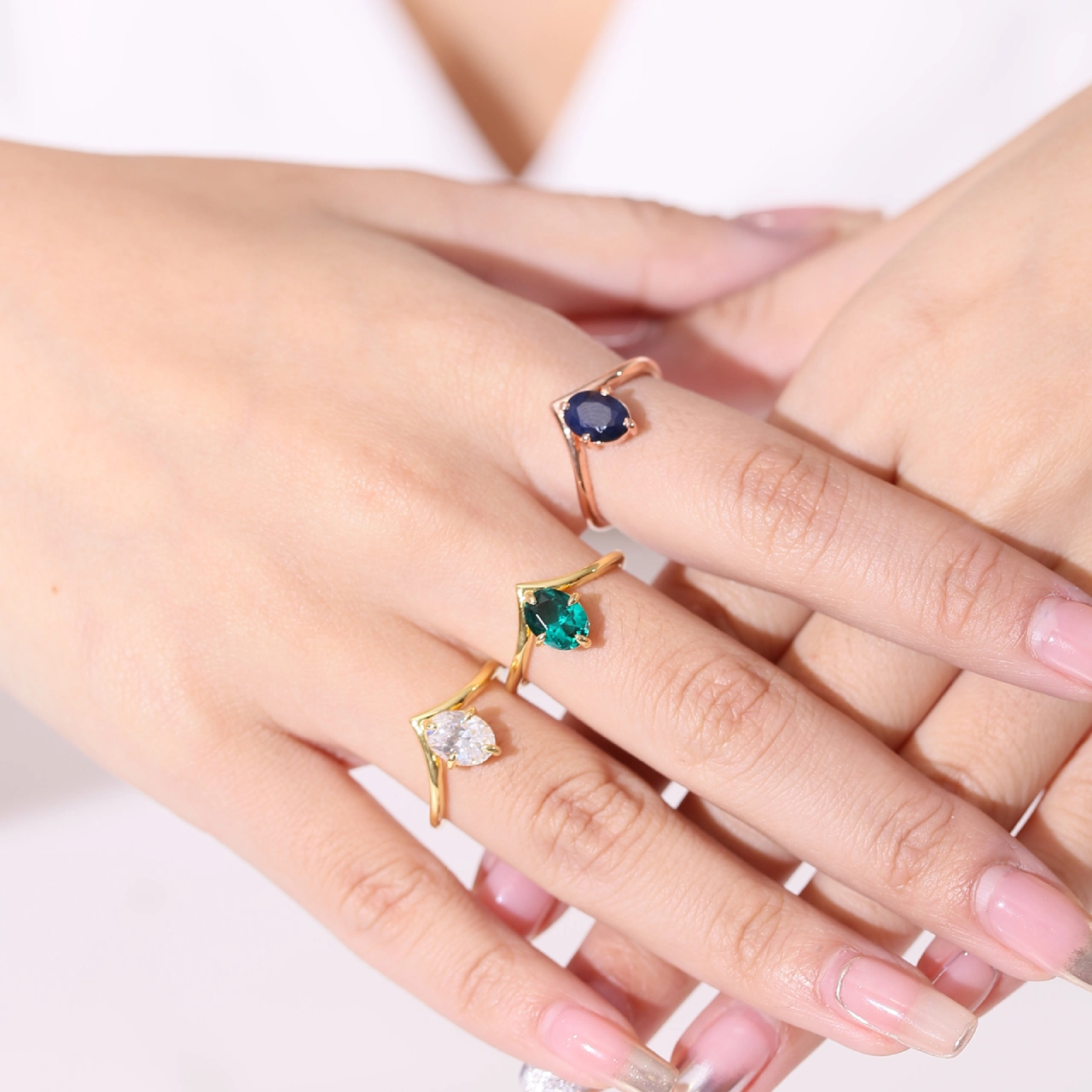
Rosery Poetry curved wedding band with natural moissanite starting from $70, SHOP NOW.
Conclusion
If you love the look of diamonds but have concerns over ethics, pricing, or both, the good news is that there are more great diamond like stones than ever.
And with cheaper diamond alternatives like moissanite that most people can't visually distinguish from diamonds, you can choose an alternative and feel great about it.
Read More
What's special about toi et moi rings? Megan Fox, Ariana Grande, Kylie Jenner...






